Blade microkeratome may still have a role in flap creation
Automated blade creates thin, precise and resilient flaps, surgeon says.
If you have used any mechanical microkeratome, the Moria One Use-Plus SBK will seem familiar. Because the unit is almost entirely preassembled, the surgeon’s only job is to set the small circular plastic analog stop between 7.5 and 9.0. The correct value is pulled from the Moria nomogram using the desired hinge width and the patient’s average keratometry.
Next, you apply the double suction ring 1 mm nasal to the line of sight, test the pressure with a handle-held tonometer, engage the microkeratome and press the forward footswitch. The blade stops 1.5 seconds later, you hit the reverse footswitch and then release suction. When you remove the instrumentation, a perfect flap is left well-aligned. The flap can be lifted with a flick, and then it is time for the excimer.
Thinner flaps
I could see the flaps were 30% thinner using the One Use-Plus SBK than what I had ever achieved with a mechanical microkeratome. The device required no learning curve and provided good consistency, reproducibility and ease of use.
I worried about buttonholes and striae, but they did not happen. I worried about difficulties with lifting the flap for enhancements, but there were none. Contrary to Moria’s advice, I used this microkeratome on patients with steep corneas, flat corneas and skinny corneas, all without incident.
After 300 eyes, the average mean central corneal flap thickness was 99 µm in the right eye and 97 µm in the left eye. No flaps were thinner than 80 µm, and none were thicker than 120 µm. My standard deviation was 8 µm in the right eye and 10 µm in the left eye. Visual results were outstanding, with 92% of eyes achieving 20/25 uncorrected acuity and 100% with 20/20 corrected acuity within 1 week of surgery. There were no lines of lost vision.
As with any mechanical microkeratome, I found a mild meniscus character to the flaps. The peripheral flap measurement at 3 mm from the corneal apex was 115 µm, or approximately 15% thicker. Although this shape is not planar, I like to describe it as semi-planar.
Smooth stromal bed
Another attribute of these flaps was the pristine nature of the underlying stromal bed. It was almost always completely dry at the end of the instrument pass and ready for excimer ablation. The texture of the stromal bed looked noticeably different from what I had experienced with microkeratomes creating thicker flaps. I began imaging these corneal beds with high-definition video and could actually quantitate the smoother texture.
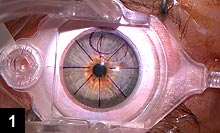 Moria One Use-Plus SBK suction footplate is applied. A 4-mm hinge size will be achieved using the 8.0 setting on the analog stop dial. |
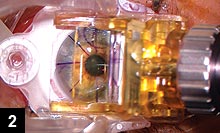 In 1.5 seconds, the mechanical microkeratome glides across the eye with minimal effort. Upon reverse, the flap lies back perfectly in the stromal bed. |
|
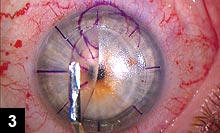 No dissection is required. The flap is pushed out of the way with a gentle flick. |
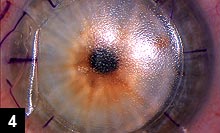 The folded back flap appears thin but consistent. The wound edge is clean and symmetric. |
|
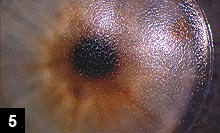 High magnification shows an even, smooth and dry stromal bed. | 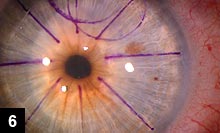 After rehydration, the flap returns to its natural position. Images: Lewis JS, Devlin M | |
Probably the most interesting observation is the strength and resiliency of these flaps. They do not have any of the tissue effects common in femtosecond flaps, and they can be lifted without breaking any adhesions. These flaps are strong and flexible. I believe they have superior tissue characteristics when compared with femtosecond flaps, and the absence of an inflammatory plasma response and tissue bridges are a major advantage to lamellar refractive surgeons.

- James S. Lewis, MD, can be reached at 8380 Old York Rd., Suite 110A, Elkins Park, PA 19027; 888-700-3937; fax: 215-886-1818; e-mail: jslewis@jameslewismd.com.
